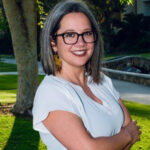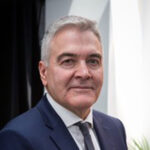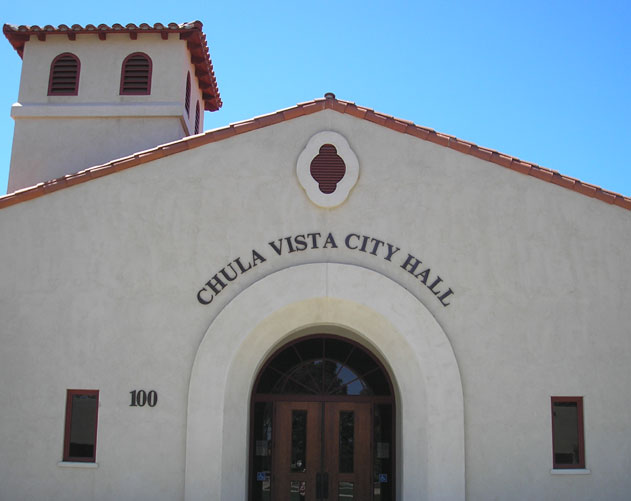The Chula Vista Democratic Club held a virtual forum on Oct. 28, giving its members and guests a chance to hear from the four declared Democratic candidates running for mayor in the 2022 election.

CVDC President Tanya Mannes Castaneda said the meeting was not for an endorsement vote from the club, but an opportunity to see where the candidates stood on housing, jobs, economic development, recovery from the COVID-19 pandemic, law enforcement and climate change. She said the purpose of the meeting was not to have a debate, but a forum, giving each candidate equal time to talk about themselves, answer predetermined questions from the CVDC, and then to answer questions from the public.

The declared candidates for Chula Vista mayor that participated in the forum were Ammar Campa-Najjar, Chula Vista Council member Jill Galvez, Zaneta Encarnacion, and Rudy Ramirez.
Campa-Najjar said he was the candidate that the country and the county chose to run for Congress against the “worst Republicans in the most Republican part of the county.” He said history was made in those elections by narrowing that regions margin of victory.

“I decided to come back to my home, my roots. I am the only candidate here that is a third generation Chula Vistan. Probably the only candidate that has lived in east and west Chula Vista.”
Campa-Najjar said he took a year off SDSU to work for the Obama campaign, working at the White House, the U.S. Department of Labor, and the U.S. Hispanic Chamber of Commerce.
“I am coming back to give back to this community that I lived in for most of my life. I do believe we need a strong candidate that can take on (Chula Vista Council member) John McCann,” he said, who beat Steve Padilla, soon to be the highest ranking Chula Vistan if he becomes state senator. He said his largest focus is to have equal equity in east and west Chula Vista.

Galvez, elected to the city council in 2018, said she began serving Chula Vista by leading all historic home tours, a Girl Scout co-leader and volunteering. Galvez has an engineering degree, but said her background is in business working for IBM and AT&T.
“I put those skills to use every single day in what now my job is, but also my passion,” she said. “I love my job. I love being a council member. I am able to make a big difference in people’s lives. Big things and small things. Being a public service has been a privilege and a big responsibility.”
Galvez said the council during her time fixed the $350 million structural budget deficit, and her personal vision is bringing free door-to-door electric shuttle vehicles for all seniors 55 and older to northwest Chula Vista. She said she has worked on projects in and out of her district to make streets safer, led a task force to combat illegal street racing, and that as a council member has cleaned up northwest Chula Vista’s graffiti, blight, potholes neglected before.
“I am excited to be your next mayor to expand the free door-to-door shuttle program, to finally lock in a university, eliminate the toll on SR 125 toll road, achieve grade separation at the trolley.” Galvez said she believes that she is the only candidate that could beat McCann in the upcoming election.
Ramirez, a lifelong resident of Chula Vista, a small business owner for 30 years, an activist serving on the International Friendship Commission, Board of Ethics, General Plan Update Steering Committee, and the Citizen’s Advisory Committee on Bayfront Development. From 2006-2014, Ramirez served on Chula Vista City Council.
“Chula Vista is not a small town anymore. We are the second largest city in the county of San Diego, 14th largest in the state,” he said. “We almost have a half billion dollar all-funds budget. But at the same time, we have a housing crisis. We have an emerging homeless population, and we have a climate emergency crisis.”
Ramirez said the city has opportunities with the Chula Vista Bayfront and a university located within the city. “I am the candidate that is most qualified, with the most experience to lead this city in its next phase of development.”
Ramirez said while on Council they passed district elections and acquired the land for the university.
Encarnacion said she has lived in Chula Vista since 2004, grew up in El Cajon and lived a transient youth because she had teen parents with no support, and that her family struggled with their basic needs. She said as a troubled youth she found herself being homeless at 13-years-old, dropping out of high school at 16 and began working at 19. Now, she said she is halfway through her doctorate program at USD.
“I share this with you so you can see what has shaped me in life and that is the power of community,” she said. “Chula Vista has given me the stability that I did not have growing up. I have worked in the community nearly 20 years to address important issues in the city. This work is reflected in the support my campaign has received from community, business, and elected leaders who want to see a mayor who truly cares about Chula Vista.”
Encarnacion said she has been asked to run many times, but until now, chose to help get others elected working on local campaigns. “I said yes this time because of this moment in time. With the backdrop of the last four years of trauma, the devastation of COVID, and the national divisiveness creeping into Chula Vista, this moment demands more from all of us,” she said.
Encarnacion said she is an experienced executive leader in both government and administration, understands the tension between policy intent and policy implementation, a proven community leader who created spaces where everyone can work together on shared values.
“Running for mayor is not a political opportunity for me, but a responsibility to make sure that Chula Vista continues to move forward,” she said.
When asked what the city was doing about the effects of skyrocketing housing market and rentals, and was it enough, Galvez said much of the housing spike was due to COVID, and that San Franciscans moved south bringing new business and opportunities to the region, but also dramatically increasing the cost of housing. Galvez said it showed that the city did not work hard enough for home buyers to meet the demand and that the city is reconsidering policies that would create more for-purchase housing.
Ramirez said the city has not done enough but trailing from leadership at the state level by losing land use authority because of the city’s ability to act locally.
He said the expansion of granny flats, affordable infill development (SB9), providing opportunities for first-time home buyers will help, but the “trick will be to find the balance.” He said he had much experience in balancing growth.
Encarnacion said this is not unique to Chula Vista, it is a problem and that the city is not doing enough. She said there are tools in place to start redevelopment, but the pandemic proved that a city can be creative and flexible than an “antiquated bureaucratic system.” She said more pathways to affordable first-time home ownerships needs to be created and that the city plays a key role. She said this can be done structurally and by policy.
Campa-Najjar said this was a problem before and after COVID and will continue unless aggressive action is taken. He said the city needs more housing, rent control or stabilization which could turn away developers, and increasing the purchasing power of the homeowner. Give them better jobs, increase their income and with the many upcoming major developments will create an opportunity to give people the purchasing power to afford the market. He said looking at housing levels to increase housing units is one solution to the shortage of affordable housing.
When asked what specific things they would do in their first 100 days to help the unsheltered, Ramirez said he would create a roaming medical unit pilot program, always checking in with people, understands who they are, their situation, and finding ways to channel them to services, and then following up.
Encarnacion said she personally knows the complexities of being homeless, and the resiliency of the unsheltered community. She said programs must provide human dignity and creating a homeless division or advisory committee will solve the issue by bringing all the players together because there is not a one sized cookie cutter approach. She said programs and services provided should mirror the resiliency of the unsheltered community.
Campa-Najjar said within 100 days he would have an advisory board of nonprofit leaders and community leaders who understand the issue. He said it is a problem hard to solve and hard to manage with around 500 unsheltered individuals in Chula Vista. Define what homeless means, including “couch surfers,” or living in their cars. He said he would look at neighbors that have great homeless outreach programs for help and working on prevention for the future. He said understanding the causes gives the ability to create solutions.
Galvez said the number one cause of homelessness is the “catastrophic breakup of the family,” and that there needs to be a focus on reunification. She said she believes they have failed the region by not having a strategy for reunification of families, and people helping other people. She said there is currently a subcommittee on homelessness, and she would like to join or take the lead and try some “fresh ideas,” because it is a multi-faceted problem.
On the city’s current financial position Encarnacion said prior to the pandemic the city was spending $10 million more than it was bringing in and that the city needs to increase its long-term sustainable revenues. “Shop local, work local, play local,” and making sure high paying jobs are coming to the city so that they can “live in the city.” She said the city has great tools with its Pension Obligation Bonds, Proposition P, Proposition A are great revenue tools to create public safety and infrastructure needs. She said the one thing missing in the budget conversation is the community voice and participation and wants to create a community based budgeting tool.
Campa-Najjar said he is troubled by the budget but has optimism for the future with the increase of property taxes by 5%, which is 18% of the general fund. He said retail taxes are coming back from the pandemic but believes there are three things that can balance the budget. Cut services, which he said they should never do, raise taxes, which he does not want to do, third is to grow the economy, with the $1.1 billion development at the bayfront, and that the small businesses around the bayfront will receive benefits from the overflow, and eventually could get the budget back into the black. He said the $58 billion from the American Rescue Plan can pad the budget today.
Galvez said she is proud for the challenging work Council did in fixing the budget deficit. She said with budget, you must be responsible, realistic, and meet all your obligations. She said Council is managing the $10 million deficit and it does not worry her, and that they must be fiscally prudent with projections, plan, and that all city departments should be involved in the process of maintaining the budget.
Ramirez said the budget is all about economic development. He said living on an international border with billions being transacted daily, but Chula Vista has failed to identify that it is the center of international trade and commerce and take advantage of it. He said the city needs to save the space for large developers and businesses to come in. He said the university will have much to do with economic development and all the proposals before did not understand how having a higher education linked with economic development and community.















